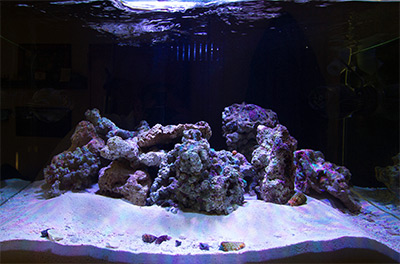Today’s marine aquarists have more options than ever before when it comes to the types of rock used to aquascape their tanks—from live rocks, whether aquacultured or wild-harvested, to all manner of dry rocks and even natural-looking man-made rocks. Each type has its advantages and drawbacks, and the choice that’s best for any given hobbyist depends on, among other factors, his or her aquascaping goals, budget, risk tolerance, and desired level of control over the system’s biodiversity.
Call me old-school (or Lord Admiral Jeff of the Universe—whichever you prefer), but my aquascaping material of choice has always been live rock, whether comprising the rockwork entirely or at least a major portion of it. Here’s why:
Fascinating biodiversity
Live rocks come loaded with organisms that emerge or hatch out for many weeks and months—even years—after they’re added to a tank. Various “pods,” fan worms, sponges, tunicates, mollusks, worms, coral colonies, macroalgae, and coralline algae are just a sampling of what might appear. And this process/progression is truly amazing to observe.
I’ve never tried it, but I think it would be fascinating to set up a live-rock-only (LRO?) tank, with no fish or intentionally introduced invertebrates, and just sit back and watch what pops out of the rocks over time. This could even make for an intriguing and educational classroom project!
Even nasty hitchhikers are interesting!
Of course, right now many of you are probably thinking, “What about all those potentially nasty critters, like Aiptasia, bristleworms, crabs, and mantis shrimps, that sometimes stow away on live rock?” This may sound heretical, but even they fascinate me.
I’ll never forget the first time I saw a particularly long bristleworm come wriggling out a piece of live rock in my tank. The sight elicited in me a strange combination of revulsion and wonderment. I also recall being surprised—I guess you could say “pleasantly”—when I shined a flashlight into my first reef tank and discovered that a stowaway crab (don’t ask me the species, but I recollect it had striking red eyes) had been residing in there undetected for months.
Now, don’t get me wrong; some live rock stowaways can become really problematic in a closed aquarium system under the right circumstances, and I’m not advocating taking a dismissive approach to their appearance. However, over the years, I’ve encountered quite a few of these critters, and more often than not, they’re no cause for panic and can be managed effectively with a little patience and persistence.
So, I guess what I’m saying is, enjoy those hitchhikers for their adaptability and, yes, even their unique beauty (remember, it’s in the eye of the beholder!) while you work at controlling or eradicating them. After all, they’re part of the natural reef, too!
Superior cycling for new systems
Last but not least, as I’ve written many times here at SWS, introducing live rock is the easiest, most straightforward way to cycle a new marine aquarium. Among the diverse micro- and macro-organisms encrusting live rock are colonies of the nitrifying bacteria that convert deadly ammonia to nitrite and then to nitrate. Also, when the rock is newly introduced, you can expect a small percentage of the encrusting organisms to die off, producing the ammonia necessary to fuel those bacterial colonies and get the cycle established.
So, in a nutshell, live rock comes with all the ingredients necessary for cycling. All you have to do is provide the appropriate water conditions and monitor the process.
What’s your preference?
So, fellow salties, do you prefer to aquascape with live rock, dry rock, man-made rock or some combination thereof? Please let us know what you use and why in the comment section below.



